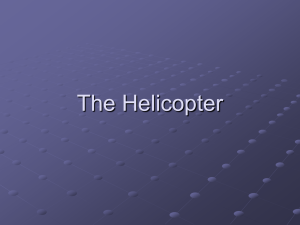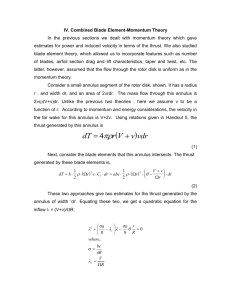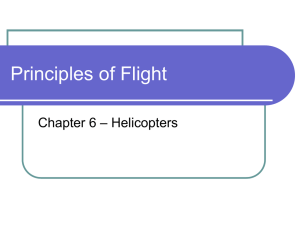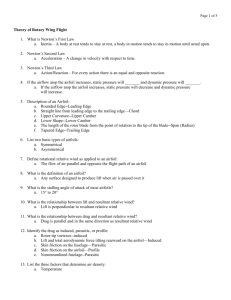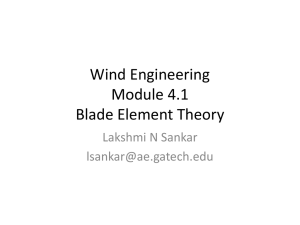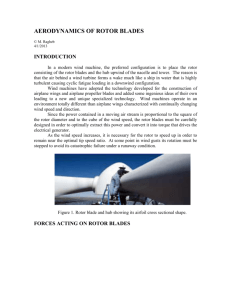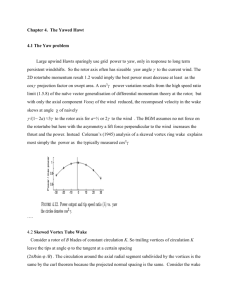Blade Element Theory for Rotor in Hover and Climb
advertisement
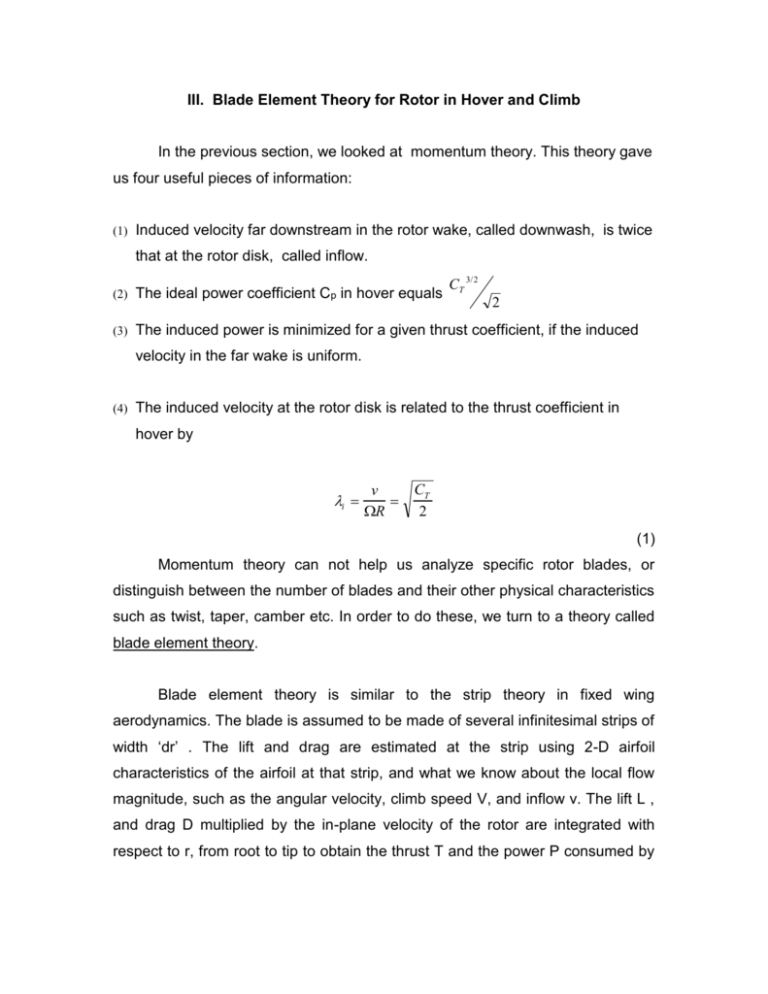
III. Blade Element Theory for Rotor in Hover and Climb In the previous section, we looked at momentum theory. This theory gave us four useful pieces of information: (1) Induced velocity far downstream in the rotor wake, called downwash, is twice that at the rotor disk, called inflow. CT 3/ 2 (2) The ideal power coefficient Cp in hover equals (3) The induced power is minimized for a given thrust coefficient, if the induced 2 velocity in the far wake is uniform. (4) The induced velocity at the rotor disk is related to the thrust coefficient in hover by i v R CT 2 (1) Momentum theory can not help us analyze specific rotor blades, or distinguish between the number of blades and their other physical characteristics such as twist, taper, camber etc. In order to do these, we turn to a theory called blade element theory. Blade element theory is similar to the strip theory in fixed wing aerodynamics. The blade is assumed to be made of several infinitesimal strips of width ‘dr’ . The lift and drag are estimated at the strip using 2-D airfoil characteristics of the airfoil at that strip, and what we know about the local flow magnitude, such as the angular velocity, climb speed V, and inflow v. The lift L , and drag D multiplied by the in-plane velocity of the rotor are integrated with respect to r, from root to tip to obtain the thrust T and the power P consumed by a single rotor blade. For multi-bladed rotors, this integrated expression is multiplied by the number of blades, b. Note: Wayne Johnson uses the symbol ‘N’ for number of blades. r dr V v r arctan Line of Zero Lift V+v r effective = Consider a typical element or strip shown below. The blade “sees” an in-plane velocity UT, that is tangential to the plane of rotation. The magnitude of U T is, of course, r, where r is the radial position of the strip. This element has a pitch angle equal to . That is, the angle between the plane of rotation and the line of zero lift is . If there were no climb velocity V, or induced inflow v, this would be the section angle of attack. These two components of velocity V and v change the flow direction by amounts , as shown in the figure above. Here, V v r arctan (2) Thus, the effective angle of attack is . The airfoil lift and drag coefficients Cl and Cd at this effective angle of attack may be looked up from a table of airfoil characteristics. The lift and drag forces will be perpendicular to, and along the apparent stream direction. These forces are given by 1 U T2 U P2 cC l 2 1 D U T2 U P2 cC d 2 L (3) The L’ and D’ have units of force per unit span. They must be rotated in directions normal to, and tangential to the rotor disk, respectively, and multiplied by the strip width dr to get the thrust and drag components, as shown below. dT L cos D sin dr dFx D cos L sin dr 1 2 U T2 U P2 cC l cos C d sin dr 1 2 U T2 U P2 cC d cos Cl sin dr (4) dP U T dFx rdFX Finally, the thrust and power T and P may be found by integrating dT and dP above from root to tip (r=0 to r=R), and multiplying the results by the total number of blades, b. The above integration can, in general, be only numerically done since the chord c, the sectional lift and drag coefficients may vary along the span. Finally, the inflow velocity v depends on T. Thus, an iterative process will be needed to find the quantity v. Approximate expressions for thrust and power may, however, be found if we are willing to make a number of approximations: a) The chord c is constant, b) The inflow velocity v and climb velocity V are small. Thus, << 1 , and i << 1. We can approximate cos(I) by unity, and approximate sin(i) by ( i). c) The lift coefficient is a linear function of the effective angle of attack, that is, . Thus, Cl a (5) where a is the lift curve slope. For low speeds, a may be set equal to 5.7 per radian. d) Cd is small. So, Cd sin() may be neglected. e) The in-plane velocity UT is much larger than the normal component UP over must of the rotor, except near the hub. With these assumptions, thrust T may be expressed as rR 1 V v T cba 2 r 2 dr 2 r r r 0 rR 1 V v V v 3 3 P cba Cd r dr 2 r r r r r 0 (6) To perform the integration, we need to know how the pitch angle varies with r. Many rotor blades are twisted, and it is not reasonable to assume that the pitch angle is constant. Two choices are common. Linearly Twisted Blade: Here, we assume that the pitch angle varies as E Fr (7) where E and F are constants. Using this definition, and performing the integration (check!), we get: T b 3 V v 3 b 1 .75 2 2 ca E FR R ca R R / 2 2R 2 4 2 3 3 abc .75 a .75 / 2 / 2 2R 3 2 3 where solidity BladeArea / DiskArea bc / R V v Inflow Ratio R CT Notice that the thrust coefficient is linearly proportional to the pitch angle at the 75% Radius. This is why the pitch angle is usually defined at the 75% R in industry. The expression for power may be integrated in a similar manner, if the drag coefficient Cd is assumed to be a constant, equal to Cd0. The final expression is (check): CP CT Cd 0 8 (8) The above expressions are true only for a linearly twisted rotor. Ideally Twisted Rotor: Here, the twist angle is inversely proportional to the radial location r. Such rotors are hard to manufacture, but turn out to have the lowest power consumption. t R r (9) Here t is the pitch angle at the blade tip. Using this in the expression for thrust given in equation (6) we get 1 R V v 2 t r dr abcR 3 t r r 4 r 0 r T 1 2 abc 2 (10) Or, CT a 4 t (11) The expression for the coefficient for power, for an ideally twisted rotor turns out to be identical to that for a linearly twisted rotor. In summary, according to the blade element theory, the following expressions are obtained. For a linearly twisted rotor in hover or climb, CT a .75 2 3 2 For an ideally twisted rotor in hover or climb, CT a 4 t For both types of twist, the power coefficient is given by C P CT Cd 0 8 The first term in the power coefficient is identical to momentum theory, and is called the induced power. The second term is due to power required to turn the rotor in a viscous flow, and is called the profile power. The Figure of Merit M is given by CT M CT Cd 0 / 8
